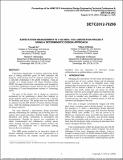| dc.contributor.author | Ichikawa, Tetsuo | |
| dc.contributor.author | Ito, Teruaki | |
| dc.contributor.author | Hanumara, Nevan Clancy | |
| dc.contributor.author | Slocum, Alexander H | |
| dc.date.accessioned | 2017-05-25T16:34:45Z | |
| dc.date.available | 2017-05-25T16:34:45Z | |
| dc.date.issued | 2012-08 | |
| dc.identifier.isbn | 978-0-7918-4501-1 | |
| dc.identifier.uri | http://hdl.handle.net/1721.1/109345 | |
| dc.description.abstract | Expectation management in product engineering design aims at setting achievable goals for both customers and designers, while leaving room for creativity and passion. This is especially challenging in the global workplace. Using an example of a design project, the Dental Headrest project (DHR), this paper reviews how expectations were managed in a successful, collaborative project between the University of Tokushima (UT) and Massachusetts Institute of Technology (MIT). The goal of the project was to design an innovative mechanism for the positioning a dental chair headrest so satisfy both the needs of a patient for comfort and a clinician for flexibility and access. The design team was formed with six students from the MIT MechE’s Precision Machine Design class, while the challenge proposed by a UT team of dentists and design engineers. The team followed a deterministic design procedure inducing understating the challenge and reviewing prior art, strategy and concept generation, detailed module design and fabrication and testing, culminating in presentation and documentation. Through the process was coordinated by online communication and collaborative working spaces which ensured real-time information transfer between the continents. The conclusion was a face-to-face meeting between the two institutions. This DHR project resulted in an innovative design of headrest adjusting mechanism that was implemented in a prototype. Moreover, the students, faculty and clinicians benefitted from the experience of innovative design collaboration in a multidisciplinary, global team. | en_US |
| dc.description.sponsorship | CIMIT: Center for Integration of Medicine and Innovative Technology | en_US |
| dc.description.sponsorship | J. Morita Corporation | en_US |
| dc.language.iso | en_US | |
| dc.publisher | American Society of Mechanical Engineers | en_US |
| dc.relation.isversionof | http://dx.doi.org/10.1115/DETC2012-70296 | en_US |
| dc.rights | Article is made available in accordance with the publisher's policy and may be subject to US copyright law. Please refer to the publisher's site for terms of use. | en_US |
| dc.source | American Society of Mechanical Engineers (ASME) | en_US |
| dc.title | Expectation Management in a Global Collaboration Project Using a Deterministic Design Approach | en_US |
| dc.type | Article | en_US |
| dc.identifier.citation | Ito, Teruaki, Tetsuo Ichikawa, Nevan C. Hanumara, and Alexander H. Slocum. “Expectation Management in a Global Collaboration Project Using a Deterministic Design Approach.” Volume 2: 32nd Computers and Information in Engineering Conference, Parts A and B (August 12, 2012). | en_US |
| dc.contributor.department | Massachusetts Institute of Technology. Department of Mechanical Engineering | en_US |
| dc.contributor.mitauthor | Ito, Teruaki | |
| dc.contributor.mitauthor | Hanumara, Nevan Clancy | |
| dc.contributor.mitauthor | Slocum, Alexander H | |
| dc.relation.journal | Volume 2: 32nd Computers and Information in Engineering Conference, Parts A and B | en_US |
| dc.eprint.version | Final published version | en_US |
| dc.type.uri | http://purl.org/eprint/type/ConferencePaper | en_US |
| eprint.status | http://purl.org/eprint/status/NonPeerReviewed | en_US |
| dspace.orderedauthors | Ito, Teruaki; Ichikawa, Tetsuo; Hanumara, Nevan C.; Slocum, Alexander H. | en_US |
| dspace.embargo.terms | N | en_US |
| dc.identifier.orcid | https://orcid.org/0000-0002-5048-4109 | |
| mit.license | PUBLISHER_POLICY | en_US |
